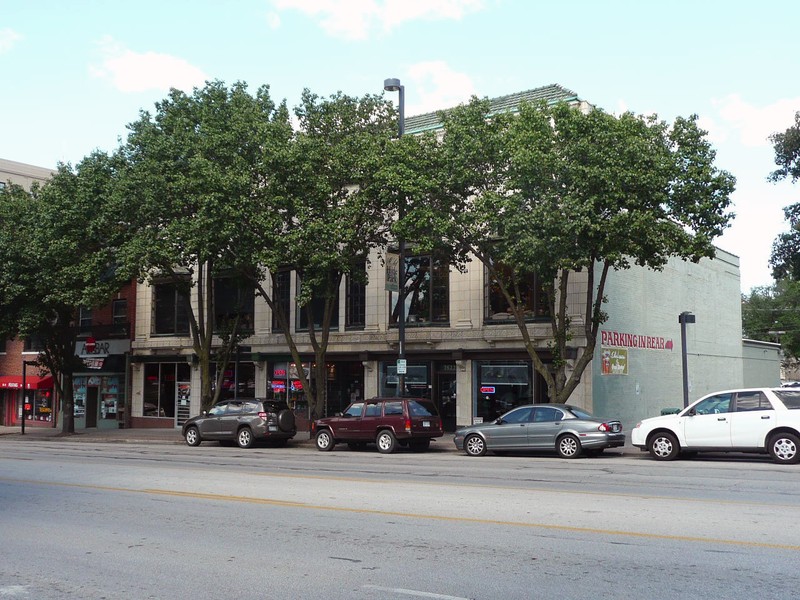Barclay Building
Introduction
Text-to-speech Audio
The Barclay Building's completion in 1924 occurred during an era of transition in this neighborhood. The area around 36th and Broadway had been home to some of the city's more wealthy residents, but the early decades of the 20th century saw new suburban neighborhoods further away from the city core. This area of Broadway was home to mixed-use structures with retail on the first floor and apartments on the second floor, often occupied by store owners and artisans who lived above their shops and studios. As shopping became more prevalent among the middle class, retail operations in some of these buildings expanded and stores occupied two floors. By the 1920s, shopping for pleasure was becoming a mark of the middle class. The increasingly middle-class residents of the area led to an increase in retailers and specialty shops. Recognizing the value of this location for their business, brothers John W. and Wilbur J. Barclay decided to move and expand their upholstery and furniture repair shop from the 3400 block of Main to this location. They opened their furniture store at this location in 1924, offering a variety of home furnishings including antique furniture. The Barclay name remains present on the building.
Images
2015 photo of the Barclay Building in Kansas City, built in 1924

Backstory and Context
Text-to-speech Audio
The Barclay Building, designed in the Beaux Arts style in 1924 by the prominent Kansas City architect, Robert F. Gomall, marked a transition from the large urban retail department storefronts of the downtown central business district to a smaller suburban retail storefront. In addition, the Barclay, as with the Garrett and Betsy Ross buildings of the same block, was a departure from the independent suburban vendor operating their business on the first floor while residing on the second floor over their shops. By centering the retail district to a single corridor, developers could open the land of the surrounding blocks to new residential opportunities.
Prior to 1900, the area south of 3600 Broadway was dotted with estates of the very wealthy businessmen and other prominent families of Kansas City society. As the population of Kansas City increased, families in the upper-middle-class began moving south as well. An apartment construction boom emerged in the neighborhood voided by the wealthy by 1909. The area was far from the noise of the central business district yet, close enough for convenient commuting via streetcars, automobiles, and a few remaining horse-drawn taxis. Still, interspersed between apartments arose several duplexes and single-family homes, where individual vendors operated their businesses from the first floor of their homes while their owners resided on the second floor. Indeed, in 1909, in the 3600 block between Broadway and Central Avenue, nine dwellings out of seventeen were occupied by a vendor on the first floor.
As the residential areas of Kansas City expanded south along Broadway during the 1920s, there was a strong demand for specialty shops, such as specialty clothing shops, grocers, and household supplies. Necessary services included cleaners, tailors, beauticians, barbershops, and a theater. The Barclay Building emerged as one of the numerous commercial buildings built in residential areas, replacing the typical two-story buildings with retail space on the first floor and residential space on the second floor, usually housing the people who owned the commercial space.
Robert Gomall designed an abundance of commercial buildings and apartment hotels along the Broadway corridor between Thirty-Fourth and Thirty-Ninth streets, most of which arose during Kansas City's building boom between 1923 and 1930. The Barclay existed as the third building he designed on the Broadway Block. Robert Gomall's design gave prominence to the second-floor shop windows, which served as display windows easily viewed by cars driving on Broadway, as well as by pedestrian traffic passing from across the street.
The Barclay Building name stems from its primary tenant, Barclay and Barclay Furniture. The Barclay brothers, John W. and Wilbur J. Barclay, had maintained an upholstery and furniture repair shop in the 3400 block of Main for several years. By 1924 the brothers had expanded their business to include antique furniture. The brothers entered a ten-year lease with the South Broadway Realty Company. The Barclay name remains intact just above the center, second-story window.
Cite This Entry
Powers, Mathew and Clio Admin. "Barclay Building." Clio: Your Guide to History. July 24, 2021. Accessed March 30, 2025. https://theclio.com/entry/138045
Sources
Millstein, Cydney E and Mary Ann Warfield. "Nomination Form: Barclay Building." National Register of Historic Places. archives.gov 2004. https://catalog.archives.gov/id/63819076 or as a pdf at: https://catalog.archives.gov/OpaAPI/media/63819076/content/electronic-records/rg-079/NPS_MO/07000042.pdf.
Smiley, Gene. "The U.S. Economy in the 1920s." Economic History Association. EH.net. Accessed July 23, 2021. https://eh.net/encyclopedia/the-u-s-economy-in-the-1920s/.

